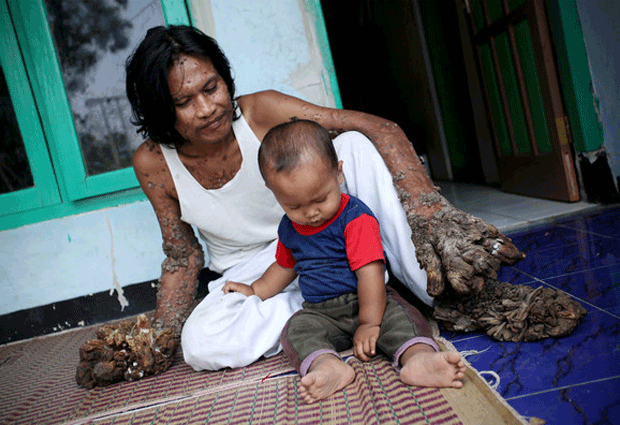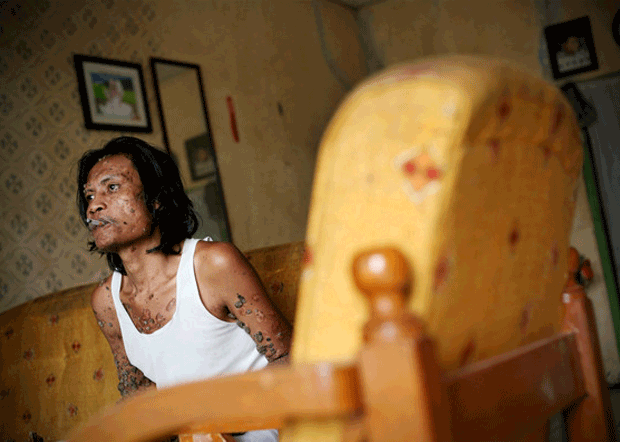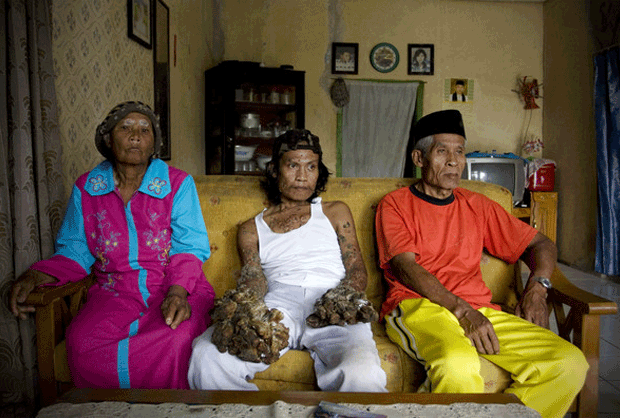|
Like every other child, Dede was born sweet and cute.
He grew up like every other child with hopes and dreams, but who would
have thought that his once beautiful and adorable physique will be a
thing of scientific experimentation later in his life. That is the story
of Dede Koswara of Indonesia.
His hands looked like contorted, yellow-brown branches extending 3 feet.
Unable to clamp his hands into a fist or pick up a fork, he made his
living by performing in carnivals in rural Indonesia. He became known as
the Treeman.
|
|
 |
|
"His life was taken away from him," said Dr. Anthony Gaspari, an
American dermatologist who traveled twice to Indonesia to treat Koswara
"He was severely disfigured and was sent into a rural isolated village
where he was sheltered from his peers. With good reason, he was a sad
man. He wanted to be cured and he wanted hope."
The growths encrusting his arms accounted for nearly 12 pounds of his
100-pound body. Koswara 36, often became exhausted after taking a few
steps because of the dense warts on his feet. The growths that carpeted
his limbs were posing more problems.
"He was getting infected," said Gaspari, chief of dermatology at the
University of Maryland Medical Center in Baltimore, Maryland. "He had
insects living in the base of the wood-like material."
Doctors believe that Koswara's case was a perfect storm, created by a
genetically inherited immune defect and a type of human papillomavirus,
or HPV. Koswara old doctors that the warts started appearing after
getting a cut in his skin as a teenager. There are hundreds of types of
HPV, some of which are linked to cervical cancer and others that cause
common warts that can be acquired through cuts.
"The HPV-2 virus that causes common warts is the same exact wart virus
that he's infected with, except it was growing out of control," Gaspari
said.
Koswara has a deficiency of white blood cells, which are crucial in
fighting infections, and his weakened immune system couldn't fight the
HPV. The virus hijacked his skin cells, causing it to produce massive
amounts of keratin, a protein found in hair and fingernails. The warts
sprouted into dense growths known medically as "cutaneous horns" on his
hands and feet.
|
|

|
|
"I had never seen anything this severe," said Gaspari, a dermatologist
for 25 years. "I shared this case with my colleagues, and no one had
ever seen this before."
Earlier in his life, Koswara ought help from local doctors, who followed
the prescribed treatment by removing the warts.
"It grew back after the operation," he says in the documentary. "It grew
back faster."
"Here's a man with chronic immune defect that had bad wart virus that
went untreated for 20 years," he said. "In an industrialized country,
this individual would have come to the attention of the health care
system and would have interventions that would prevent it from
progressing. That's the reason why it developed into an extremely
bizarre, unusual appearance."The skin treatments didn't work, because
they didn't address his weakened immune system, and Koswara could not
afford more medical procedures, Gaspari said.
As Koswara aged, his condition worsened. The horns clustered on his
limbs, where the body temperature is lower. They grew at a rate of 5
millimeters a month. Warts that looked like barnacles began to clump
around his eyes and nose.
|
|

|
|
"I am afraid that it will cover all my face," Koswara told an Indonesian
journalist. "I won't be able to see. I won't be able to eat."
The growing of the warts was not painful, Gaspari said. But the
cutaneous horns were attached to the skin, and Koswara would feel pain
if they were pulled or entangled.
As the growths took over his hands and feet, Koswara lost his
independence, and his wife left him. He had worked in construction and
fishing but could not longer work.
"He has a wonderful family," Gaspari said. "That's why he was able to
survive as long as he did."Koswara's siblings and parents cared for him,
feeding and cleaning him. His condition is not contagious, and his
family members have not been infected with similar skin growths.
To support his two teenage children, Koswara joined a traveling
performance group with people who have various skin deformities.
"I try to be a good father, but I can't give them what they need," he
said in the documentary."I feel sad, because I cannot touch them."
Similar cases of uncontrollable wart growths have been reported in China
and Romania. In 2007, Chinese researchers reported two unrelated male
patients who developed cutaneous horns on their limbs. Both patients had
the same type of HPV infections, according to studies.
In 2007, as word spread about Koswara's condition, he was brought into
an Indonesian hospital for treatment. About 12 pounds of cutaneous horns
were sawed from his hands and feet. Skin grafts were taken from his back
and buttocks and placed on his forearm.
Gaspari often disagreed with the Indonesian doctors' procedures such the
skin grafts, saying it was invasive and could be infected with the
virus.
After several surgeries, Koswara has been able to walk, lift a fork and
write. He was discharged from the hospital in early September. The warts
have been reappearing, but Koswara is receiving chemotherapy to stop the
virus.
Gaspari continues to monitor Koswara's progress through e-mails and
teleconference calls with Indonesian doctors.
"You can see the outlines of his hands," Gaspari said. "It's still
covered in warts. Before, you couldn't tell the top from the bottom. He
has definitely made progress and gained some weight."
The experts are waiting to learn more about Koswara's reaction to the
medical treatments, Gaspari said. "The story has not fully unfolded
yet."
Unfortunately, months after, the warts started growing back, faster than
it use to be. Doctors are unrelenting, and deem Dede's rare case as a
medical challenge.
|